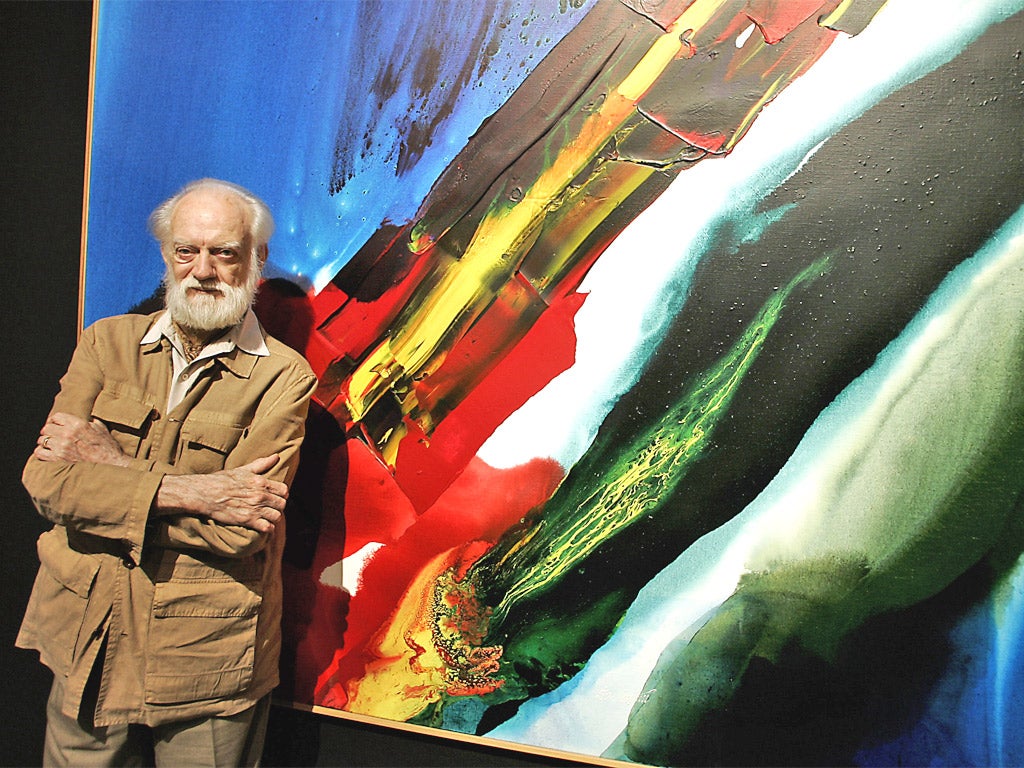Paul Jenkins: Painter whose art brimmed with the energy of life

The American artist Paul Jenkins, whose unorthodox application of paint by an alchemy of pouring techniques brought him association with the great Abstract Expressionists, has died in New York City at the age of 88. Born in a lightning storm in Kansas City in 1923, he started as he meant to go on, enjoying a somewhat epic life which found friendship with luminaries such as Jean Dubuffet, Mark Rothko, Jackson Pollock and Willem de Kooning et al, whose support of him was as noteworthy for its affection as for its endurance – a distinction not always granted to artists at the top of the pile.
He was a softly spoken, warm and familial person at first meeting. When young, he resembled a prophet in the making; in later life he fully looked the part and to an extent lived it: greatly interested in astrology, his first question on meeting would be to ascertain people's sun sign. Thereafter he would formulate an informed opinion of their likely behaviour and feelings about one another, while encouraging the best of their skills and talents. The study of Eastern religions, the I Ching and Jungian philosophy compounded the measured spirituality of his existence, and made him congenial company.
Paul Jenkins was the only child of a Missouri realtor from whom his mother was soon divorced, a circumstance that impacted significantly on him. His great uncle was a friend of Frank Lloyd Wright and a preacher who influenced him greatly, including via his own personal motto, "live dangerously".
For Jenkins, however, a home-loving Cancerian to the core, this mostly translated into early extended periods of travel to Europe, following his art training at Kansas City Art Institute (and an apprenticeship in a ceramics factory) funded on the GI Bill via the Art Students League. He went initially to Sicily, then Spain, and later to France, which in time became a second home for the rest of his life.
His first exhibition was held in Paris in 1954; his first in the US was in Seattle in the following year, and that city's museum was the first one to acquire his work. Eighty-five museums in more than 10 countries followed suit. In addition, he continually showed in private galleries worldwide, the last of which in the UK being in 2011 at Redfern Gallery, London, who had represented him since 2002.
Redfern Gallery shared with Paul Jenkins a birth year of 1923, an auspicious fact behind his selection of it as a UK agent. His last exhibition was with Robert Green Fine Arts, Mill Valley, near San Francisco, earlier this year. One show eluded him while he was alive, however: he was proud of his Welsh ancestry, and given that the National Museum of Wales had acquired five of his works he always hoped for an exhibition there. In 1964 he donated a bust of the poet Dylan Thomas to the Museum, via the actor Richard Burton, in a ceremony in Manhattan.
As might also be expected, Jenkins' homes were places of warmth and comfort. In New York's Upper East Side, his brownstone house was ranged with choice acquisitions of all kinds: prisms and oriental objects of art as well as decorative panels devised as collages comprising paper and wood. Added to these were stones, rocks and found objects that to him were irresistible and gathered for their sometimes mystical powers. He retained homes in Paris and also in St Paul de Vence, near Nice, where he'd converted a sizeable industrial building into a home and workspace. This was also filled with masses of decorative items, lovingly collected. From the mid-1950s, half of each year he spent in New York, half in Paris or Provence.
In 1977 he met the photographer and art historian Suzanne Donnelly when she began work on his archive material that eventually became their joint book Anatomy of a Cloud, a giant tome – one of 24 by him in total – published in 1983 by Harry N Abrams. Work on the archives continued and over 12 linear feet of archive material are held by the Smithsonian Institution covering his life dating from 1932 to 2009, including time in the 1950s and '60s spent in NYC and Paris. He and Suzanne married in 1979.
Paul Jenkins' work has been painstakingly described and dissected by art critics, who have attempted to put across his meltingly apocalyptic, eerily monumental commitment to a life steeped in appreciation of energy in its myriad forms. What maybe is clearest to most observers of them is that they are accessible paintings – rather as he was himself, although their depths are not necessarily the easiest to figure out – multi-layered, and highly regarded.
In an unusual move, the Strand Bookstore on Broadway – which as a lover of books he frequented – devoted an entire window to him when they learnt of his death.
Julian Machin
Paul Jenkins, painter and writer: born Kansas City 12 July 1923; married firstly Esther Ebenhoe, secondly Alice Baber, thirdly Suzanne Donnelly; one daughter; died New York City 9 June 2012.
Join our commenting forum
Join thought-provoking conversations, follow other Independent readers and see their replies
Comments